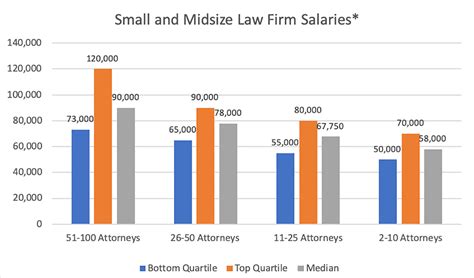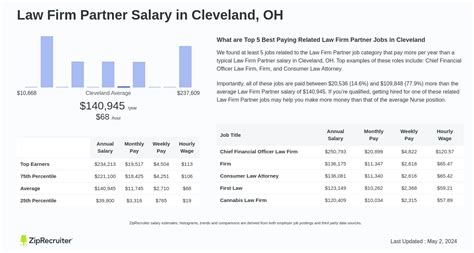Becoming a partner at a law firm is widely considered the pinnacle of a legal career. It signifies not just mastery of the law, but also exceptional business acumen and leadership. This prestige is accompanied by significant financial rewards, with compensation packages that range from a very comfortable six figures to well into the seven-figure-plus territory annually.
If you're an aspiring lawyer or a current associate with your eyes on the prize, understanding the nuances of partner compensation is crucial. This article breaks down the average salaries, the critical factors that dictate your earning potential, and the career outlook for this demanding but highly rewarding role.
What Does a Law Firm Partner Do?

While a junior lawyer (or "associate") is primarily focused on executing legal work—research, drafting documents, and assisting in cases—a partner’s responsibilities expand dramatically. A law firm partner is both a top-tier lawyer and a business owner.
Their key duties include:
- Rainmaking: Actively generating new business and bringing clients to the firm. This is often the most important function of a partner.
- Client Management: Nurturing and maintaining relationships with the firm’s most important clients.
- Strategic Leadership: Contributing to the firm's overall strategy, growth, and financial health.
- Mentorship and Management: Supervising teams of associates and paralegals, ensuring high-quality work, and training the next generation of lawyers.
- High-Level Legal Work: Handling the most complex and high-stakes aspects of cases and transactions.
In essence, a partner drives the firm's revenue and reputation.
Average Law Firm Partner Salary

Pinpointing a single average salary for a law firm partner is challenging due to the vast differences in roles, firm types, and compensation structures. However, data from leading salary aggregators provide a strong baseline.
According to Salary.com, the median law firm partner salary in the United States is $243,101 as of May 2024. The typical salary range falls between $208,401 and $283,201. Similarly, Glassdoor reports a national average base pay of $251,000 per year, with total pay potentially rising much higher with bonuses and profit-sharing.
It is critical to understand that these figures often represent partners at mid-size firms or "non-equity" partners. For equity partners at major law firms, these numbers are merely a starting point, as their total compensation can be multiples higher.
Key Factors That Influence Salary

A partner’s salary is not a monolith. It is a complex calculation influenced by several key variables. Understanding these factors will give you a much clearer picture of your potential earnings.
### Level of Education
To become a lawyer, a Juris Doctor (J.D.) degree is mandatory. While the law school you attend doesn't directly set your partner-level salary, graduating from a top-tier ("T14") law school can provide a significant head start. These schools are heavily recruited by "Big Law" firms—the highest-paying firms in the industry—making it easier to get on the lucrative partner track early.
Furthermore, supplementary degrees can enhance earning potential in specialized fields. An LL.M. (Master of Laws) in Taxation is highly valued for tax partners, while an M.B.A. can be advantageous for those specializing in corporate law and private equity.
### Years of Experience
Experience is arguably the most powerful driver of a partner’s compensation, and it’s deeply intertwined with their status as either a non-equity or equity partner.
- Non-Equity Partner: This is often the first step on the partnership ladder, typically achieved after 7-10 years as an associate. Non-equity partners are salaried employees. While their salary is significantly higher than that of a senior associate and they receive bonuses tied to performance, their income has a ceiling.
- Equity Partner: This is the ultimate goal. An equity partner is a part-owner of the firm who contributes capital and shares in the firm's profits. Their compensation is a "draw" or a share of the profits, which can lead to enormous earnings in a good year. A senior equity partner with 20+ years of experience and a massive book of business will be among the highest earners in the legal profession.
### Geographic Location
Where you practice law matters immensely. Major metropolitan areas with a high concentration of corporate headquarters, financial institutions, and tech companies command the highest salaries due to a larger client base and higher billing rates.
According to industry data, the top-paying legal markets in the U.S. include:
- New York City, NY
- San Francisco Bay Area, CA
- Los Angeles, CA
- Chicago, IL
- Washington, D.C.
- Boston, MA
Partners in these cities can earn 25-50% or more than their counterparts in smaller cities or rural areas.
### Company Type
The size, prestige, and financial model of the law firm are dominant factors in determining partner pay.
- "Big Law" (Am Law 100/200 Firms): These are the largest and most profitable firms in the world. Here, compensation is often discussed in terms of Profits Per Equity Partner (PPEP). According to reports from publications like *The American Lawyer*, the average PPEP at the top 100 firms regularly exceeds $2 million, with the most elite firms boasting PPEP of over $5 million.
- Boutique Firms: These smaller, highly specialized firms can also be incredibly lucrative. A successful boutique focused on a high-demand niche like intellectual property litigation or private equity can generate partner profits that rival or even exceed those at many Big Law firms.
- Mid-Size and Small Firms: These firms offer a broader range of legal services and typically have lower billing rates. Partner compensation is more modest, often aligning with the national averages in the low-to-mid six-figure range. However, these roles may offer a better work-life balance and a more direct impact on the local community.
### Area of Specialization
Not all legal practice areas are created equal when it comes to compensation. The most lucrative specializations are those that serve large corporate clients and involve high-stakes transactions or litigation.
- Most Lucrative Practice Areas: Corporate Law (especially Mergers & Acquisitions and Private Equity), Capital Markets, Tax, Intellectual Property, and complex Commercial Litigation.
- Less Lucrative Practice Areas: While still providing a very good living, areas like Insurance Defense, Family Law, and Criminal Defense (with the exception of top-tier white-collar defense) generally have lower billing rates and, consequently, lower partner compensation.
Job Outlook

The legal profession continues to show steady growth. The U.S. Bureau of Labor Statistics (BLS) projects that overall employment for lawyers will grow by 8% from 2022 to 2032, which is much faster than the average for all occupations. The BLS notes that the median annual wage for all lawyers was $145,760 in May 2023, underscoring the significant financial leap that partnership represents.
While the profession is growing, the path to partnership remains exceptionally competitive. Law firms operate on a pyramid structure, with many associates vying for a limited number of partner spots. Success requires not only legal excellence but also a demonstrated ability to develop business.
Conclusion

The title "law firm partner" carries immense prestige and the potential for extraordinary financial success. However, the salary is not a single number but a vast spectrum. For those considering this path, the key takeaways are clear:
1. Equity is Everything: The leap from a salaried non-equity partner to a profit-sharing equity partner is where wealth is truly created.
2. Firm and Location are Paramount: Your choice of firm (Big Law vs. boutique vs. small) and city will have the biggest impact on your earning potential.
3. Specialize Wisely: High-value corporate and transactional practices consistently yield the highest returns.
4. It's a Business Role: Beyond legal skill, the ability to attract and retain clients is what ultimately defines a successful—and highly compensated—partner.
The road to partnership is a marathon, not a sprint. It demands years of dedication, long hours, and relentless focus. But for those who reach the summit, the professional and financial rewards are among the greatest in any profession.
